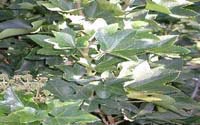Resource Library
Plant of the Week: Botanical Wonder
The University of Arkansas System Division of Agriculture does not promote, support or recommend plants featured in "Plant of the Week." Please consult your local Extension office for plants suitable for your region.
Plant of the Week
[A-Z]
Botanical Wonder
Latin: x Fatshedera lizei

Through the ages, nature has produced an array of plants and animals that are each unique.
Man, with his penchance for order has classified the natural world into a taxonomic arrangement which helps discern relationships and place each species in its own unique cubby hole. But as soon as you develop a really nifty system, something always comes along that doesn ’t quite fit.
From the plant world one of these oddballs is x Fatshedera lizei, the Botanical Wonder.
Fatshedera is a hybrid of two members of the aralia family, Fatsia japonica ‘Moseri’ and Hedera helix ‘Hibernica’ (English Ivy). Fatsia is a 10-foot tall, erect-stemmed evergreen shrub with lobed, leathery leaves the size of a large dinner plate. Fatshedera, the freak of nature that it is, has characteristics between those of Fatsia and the vining English ivy.
Botanical Wonder can’t make up its mind if it wants to stand upright like its momma or vine like it’ s daddy. So, being undecided, it kind of sprawls. Plants will grow 3 to 4 feet tall and then fall over with new erect stems again arising from the base.
The leaves of Fatshedera are star shaped and 5 to 6 inches across with long petioles. They have the typical leathery texture of both parents and are evergreen, at least where the plant is hardy, which is mostly in the southern third of Arkansas.
Greenish flowers appear on older plants in the fall in golf ball-sized balls similar to those seen on adult English ivy vines. However, being a bigeneric hybrid, the plant is sterile and produces no seeds.
The binomial (two-name) classification system we use today was developed by the Swedish botanist Carlos Linnaeus (1707-1778). Linnaeus tried to classify all plants according to their sexual parts, a system that never really worked, but his binomial technique became the framework we use for classifying all things in the natural world.
The binomial system works the way Chinese personal names are given; the surname is given first with the given name second. Using this system, Hedera helix can easily be differentiated between all other species of Hedera.
Genera are grouped according to similarities into plant families. The more distant the relationship between plants, the less likely they are to be sexually compatible. Hybrids between genera within families are rare but do occur. The "x" is used to indicate a plant is of hybrid origin.
Botanical wonder was discovered as a chance seedling by a nurseryman in 1910 in Nantes, France. Several variegated cultivars of the plant are available.
Fatshedera is primarily recommended as a houseplant, but as such you must develop an appreciation for slouchiness. Ruthless cutting back will give it a better form and do wonders at relieving stress. Inside, it is easy to grow in a cool, bright window.
In the garden, Fatshedera is worth having just for its unique botanical background. Even in Zone 8, it tends to freeze back occasionally, so giving the plant a south or west facing position next to the house will help assure its survival. In colder areas, it can be grown but will freeze to the ground each winter. The sprawling stems, when given a little assistance by means of a few wire supports, can be trained to "climb" a fireplace. The variegated selections are less hardy than the green form.
By: Gerald Klingaman, retired
Extension Horticulturist - Ornamentals
Extension News - March 15, 2002
The University of Arkansas System Division of Agriculture does not maintain lists of retail outlets where these plants can be purchased. Please check your local nursery or other retail outlets to ask about the availability of these plants for your growing area.